Xing GUO, Jing WANG, Bine XUE, Daniel C. THOMAS, Yvonne C. F. SU, Yun-Hong TAN, Richard M. K. SAUNDERS
The systematic position of two enigmatic Annonaceae species from China, Desmos saccopetaloides (W. T. Wang) P. T. Li and Desmos yunnanensis (Hu) P. T. Li, has been controversial, with both species having been transferred between several different genera within subfamilies Annonoideae and Malmeoideae. Phylogenetic analyses of eight chloroplast regions (matK, ndhF, ndhF-rpl32, psbA-trnH, rbcL, rpl32-trnL, trnL-F, and ycf1; ca. 9.2 kb, 66 taxa) unambiguously placed D. saccopetaloides in a subclade of tribe Miliuseae, nested among the genera Monoon, Neo-uvaria, Phaeanthus, Sageraea, and Stelechocarpus. This relationship was also supported by endosperm rumination patterns in the seed; other morphological characters furthermore indicated that D. saccopetaloides has closer affinities withMonoon, Neo-uvaria, and Phaeanthus rather than either Sageraea or Stelechocarpus. Desmos saccopetaloides is distinguished from these genera by its leaf-opposed inflorescences, sepaloid outer petals, saccate inner petals with basal glandular tissue, moniliform monocarps with uniseriate seeds, and rectangular disulculate pollen with two “cryptoapertures.” On the basis of the combined molecular phylogenetic and morphological data, we propose a new genus, Wangia, to accommodate D. saccopetaloides. The molecular phylogenetic analyses furthermore indicated that D. yunnanensis belongs to the genus Dasymaschalon: examination of the type collections revealed that it is conspecific with Dasymaschalon obtusipetalum, although the combination Dasymaschalon yunnanense has nomenclatural priority.

